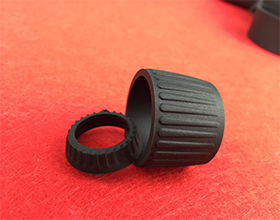Zhongshan Hexin Rubber & Plastic Electronics Co, Ltd. is customer-oriented, ensuring high quality products is the basis for survival. From the beginning to now, it has a good cooperation relationship with the world's major brands of telescopes, optical instrument manufacturers and some well-known optical instrument enterprises in China
What are the characteristics of rubber?
1. The elastic modulus of rubber with high elasticity is small, generally in the range of 1-9.8 MPa. The elongation deformation is large, the elongation can be as high as 100%, it still has the characteristic of recovery, and can keep elasticity in a wide range of temperature (- 50 - + 150 ℃).
2. Viscoelastic rubber is a viscoelastic body. Due to the existence of intermolecular force, the rubber is affected by external force. The deformation is affected by time, temperature and other conditions, showing obvious stress relaxation and creep phenomenon. Under the periodic action of vibration or alternating stress, hysteresis loss occurs.
3. Rubber has the function of buffering and shock absorption, which can be used to prevent noise and vibration.
4. Rubber is an electrical insulating material just like plastic. For example, natural rubber and butyl rubber and volume resistance can reach 10
5. Polymer materials with temperature dependence are generally affected by temperature. At low temperature, rubber is in glass state and becomes hard and brittle. At high temperature, rubber will soften, melt, thermal oxidation, thermal decomposition and even combustion.
6. It has aging phenomenon, just like metal corrosion, wood decay and rock weathering, rubber will also be aged due to changes in environmental conditions, resulting in deterioration of performance and shortening of service life.
7. The rubber must be vulcanized. Sulfur or other substances that can make rubber vulcanization (or cross-linking) must be added to make rubber macromolecules cross-linked into space network structure, so that rubber products with use value can be obtained, but thermoplastic rubber can not be vulcanized.
What are their uses?
1. Natural rubber (NR) is a kind of non-polar substance, which is mainly composed of rubber hydrocarbon (polyisoprene) and contains a small amount of protein, water, resin acid, sugar and inorganic salt, etc. It has the advantages of high elasticity, high tensile strength, good tearing resistance and electrical insulation, good wear resistance and drought resistance, good processability, easy to bond with other materials, and superior to most synthetic rubber in comprehensive properties. The disadvantages are poor resistance to oxygen and ozone, easy aging and deterioration; poor oil and solvent resistance, dissolved before vulcanization in cyclohexane, gasoline and benzene, and swelling after vulcanization. It is resistant to 10% hydrofluoric acid, 20% hydrochloric acid, 30% sulfuric acid and 50% sodium hydroxide, and its heat resistance is not high. Operating temperature range: about - 60 ℃ ~ + 80 ℃. Make tires, rubber shoes, hose, tape, insulation and sheath of wires and cables and other general products. It is especially suitable for manufacturing torsional vibration eliminator, engine shock absorber, machine support, rubber metal suspension components, diaphragm and molded products.
2. Styrene butadiene rubber (SBR) copolymer of butadiene and styrene. Its properties are close to that of natural rubber, and it is the largest general synthetic rubber with more wear resistance, aging resistance and heat resistance than natural rubber, and its texture is more uniform than natural rubber. The disadvantages are: low elasticity, poor flexure and tear resistance, high heat generation under repeated deformation, poor oil, heat resistance and special medium resistance; poor processing performance, especially poor self viscosity and low raw rubber strength. Service temperature range: about - 50 ℃ ~ + 100 ℃. It is mainly used to replace natural rubber to make tires, rubber plates, rubber tubes, rubber shoes and other general products.
3. CIS polybutadiene rubber (BR) is a cis structure rubber polymerized from butadiene. It does not need to be plasticized and belongs to polar substance. The advantages are: excellent elasticity and wear resistance, good aging resistance, excellent low temperature resistance, small heat output under dynamic load, easy metal bonding, good chemical stability, and can resist the corrosion of most chemicals except strong acid. The disadvantages are low strength, poor tear resistance, poor processability and self adhesion. Operating temperature range: about - 60 ℃ ~ + 100 ℃. It is commonly used with natural rubber or styrene butadiene rubber. It is mainly used to make tire tread, conveyor belt and special cold resistant products.

4. Isoprene rubber (IR) is a cis structure rubber which is polymerized by isoprene monomer. The chemical composition, three-dimensional structure and natural rubber are similar, the performance is also very close to natural rubber, so it is called synthetic natural rubber. It has most of the advantages of natural rubber, aging resistance, because natural rubber, elasticity and strength is slightly lower than natural rubber, processing performance is poor, high cost. Application temperature range: about - 50 ℃ ~ + 100 ℃. It can replace natural rubber to make tire, rubber shoes, rubber hose, tape and other general products.
5. Chloroprene rubber (CR) is a polymer made from monomer polymerization of chloroprene. This rubber molecule contains chlorine atom, so compared with other general rubber, it has excellent oxygen resistance, ozone resistance, non flammable, self extinguishing after ignition, oil resistance, solvent resistance, acid and alkali resistance, aging resistance, air tightness and other advantages; its physical and mechanical properties are better than natural rubber, so it can be used as general rubber and special rubber. The main disadvantages are poor cold resistance, large proportion, high relative cost, poor electrical insulation, easy to roll, scorch and stick mold during processing. In addition, the raw rubber has poor stability and is not easy to preserve. Service temperature range: about - 45 ℃ ~ + 100 ℃. It is mainly used for manufacturing cable sheaths with high ozone resistance and aging resistance, various protective covers and protective covers, oil and chemical corrosion resistance





